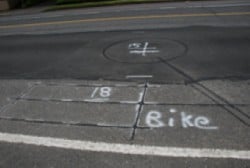
detector installed at 21st and
Sandy has reduced delay for
bicycle traffic by 15%.
(Photo: PBOT)
The City of Portland Bureau of Transportation (PBOT) understands that in order to make bicycling more attractive — and to reach its goal of 25% bike mode share by 2030 — riding a bike must compete better with driving a car. Put another way, bicycling must be seen by a larger number of people as being a convenient option. Beyond building bike-friendly infrastructure, there are other ways to accomplish this sense of convenience. One way to make bicycle travel more efficient is by building a system that causes fewer delays for bicycle traffic.
“This installation will move away from favoring automobiles over other modes by providing advanced detection for both motor vehicles and bicycles, rather than only for automobiles as is currently the case.”
On that note, PBOT has applied for a $250,000 grant from the Oregon Department of Transportation (through their Federal Flexible Fund program) to install 50 advanced inductive loop detectors in bike lanes. Currently, bike loop detectors are installed right at the intersection. These new advanced detectors, which are common on standard vehicle lanes, would be placed well before the intersection. The three main benefits of these new detectors would be:
- They would warn the traffic signal that someone on a bike was coming so the signal could remain green longer, thereby reducing delay;
- by having longer green cycles, the loops would help eliminate what’s known as the “dilemma zone” of trying to decide whether to run a yellow light or stop suddenly;
- and the advance detection loops would also collect valuable data on bicycle volumes at intersections.
According to their grant application (which is titled, Portland’s “Green” Traffic Signals: Reducing Delay on Portland’s Bicycle Network), PBOT wants to, “provide the same service to bikes that it currently provides to vehicles.” The primary motivator for PBOT with this project is to reduce delay experienced by bicycle traffic and to put bike lanes on equal footing with standard lanes. Here’s an excerpt from the grant application:
“… When retrofitting an existing transportation system specifically designed for cars to accommodate non-auto users, increasing connectivity and improving operations for non-auto users while maintaining adequate service for automobiles is challenging. The City of Portland sees that installing advanced loop detection for bicycles is one component of achieving this goal. This installation will move away from favoring automobiles over other modes by providing advanced detection for both motor vehicles and bicycles, rather than only for automobiles as is currently the case.”
PBOT feels that the new advanced bike loops would lead to increased bicycle use because they will increase the convenience of cycling relative to other modes. In the grant application, PBOT notes that at an initial screening of potential locations, they observed a significant reduction in delays — as much as 45 seconds on average — at intersections for bicycle traffic.
In addition to delay reduction, PBOT says advanced detection loops improve safety because they eliminate the dreaded “dilemma zone,” which is that decision point when a light turns yellow and you can’t decide to speed up (and risk running the light/getting hit) or stop suddenly (and risk getting hit from behind). Here’s how the advanced detectors could help with eliminate that:
“By installing advanced detection at intersections, a green indication is held if a bicycle crosses the detector before the signal turns yellow. As a result, the bicycle is allowed to proceed into the intersection with a green signal and the dangerous dilemma zone is ideally eliminated.”
The advanced loop detectors would also be a boon to researchers and planners who would get invaluable information on bike traffic volumes.
PBOT’s request of $250,000 will compete for $21 million in federal transportation funds being awarded by ODOT. Back in August, acting on direction provided to ODOT in the 2009 legislative session to spend more money on non-highway projects, the Oregon Transportation Commission (OTC, which advises ODOT) decided to put aside $21 million from the Surface Transportation Program and award it solely to transit, biking, walking, and transportation demand management (TDM) projects. It’s all part of their movement toward a more “non-highway” future that we reported on back in June.
The OTC will decide on which projects to fund by February 2011. If awarded, PBOT estimates they could complete this project in four to six months.

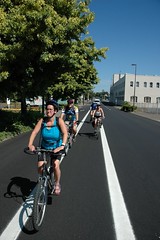
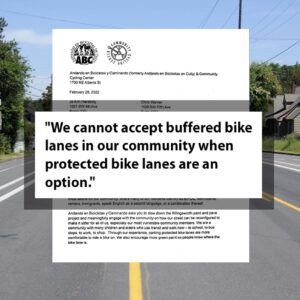
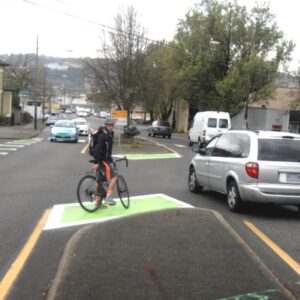
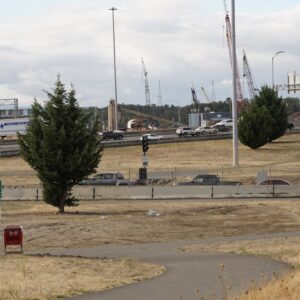
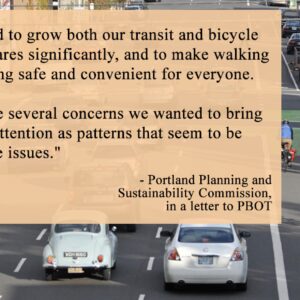
Good job PBoT (and ODoT).
This type of enhancement would also:
1) reduce the ‘confusion’ by drivers seeing bicyclists ahead (like myself) who drift out and in of the bike lane in order to trigger the existing auto advanced loop detector when none exist; and
2) it would also allow the option of installing a “no right turn on red” signal linked to this loop detector when appropriate.
Jonathan…what is the link to this grant? So we can read more about it and any updates on submitted proposals?
Dammit Portland, stop making me want to move there. I recently got a $287 ticket for failing to clear a wide intersection on my bike before the light turned red. 6 lanes and a huge median. 5.2 seconds of yellow. When pleading my case before the judge, I was told “if you can’t get across that intersection in time, find another one.” That’s one way to look at it; PBOT’s is another.
Nathan, what town are you in?
@ Nathan: Wow, that’s insane.
this sounds awesome – I’ll have to check out the one on 21st and Sandy, as I live right near there.
Yayyyy PBOT! This is awesome!
I wonder how the Oregon Transportation Commission is picked… does the Governor nominate members? Looking at the current members, the chair has had considerable sustainability experience. The other members’ bios do not mention such connections. Given that they decide funding like this, a progressive Commission could do a lot for active transportation in Oregon. Anybody know how they’re chosen? Is there room for citizen activism w.r.t. commission appointments?
from http://www.oregon.gov/ODOT/COMM/otc_main.shtml :
“The governor appoints five commissioners, ensuring that different geographic regions of the state are represented. One member must live east of the Cascade Range; no more than three can belong to one political party.”
Glad you asked Alex. You can learn more about the OTC and its members in this story we published back in March 2009.
Thanks Nathan and Jonathan! Good info.
who said “provide the same service to bikes that it currently provides to vehicles”? they’re supposed to be sensitive to their wording… in that sentence it states that bicycles are not vehicles, but we know they are… they should have used “motor-vehicles” instead of “vehicles”…
and with the function of the “green indication is held if a bicycle crosses the detector before the signal turns yellow” does that follow the same behavior as the advanced detectors for cars at the same signal? I sure hope so, because we don’t want cars weaving into the bike lane just to ensure the light stays green… I’m assuming it will mimic the car system, so that neither the cars nor the bikes will be swerving into each others lanes to trip sensors…
lastly, the picture shows a rectangular quadrupole detector loop… I thought those were being phased out in favor of circles…
Given how many people I know who ride bikes a lot and still are unaware of how to use the loops, I doubt many drivers will ever even figure it out.
Nice! Now if we could only get rid of those infernal buttons pedestrians have to push to cross the street.
Agreed!
Also – an RFID reader in there so those of us who want to optionally put an RFID tag on their pride & joy might be able to recover it when it gets stolen by some d@#khead. Nah, just kidding, cops still wouldn’t respond.
not a bad idea… report the RFID stolen and when it passes over a sensor the red light camera snaps a picture and alerts police…
Idaho stops for bikes make more sense, and far cheaper.
This is awesome!
Don’t quote me but I have heard our yellow lights are 3.5 seconds. I think they are talking about changing them to 4 seconds for red light cameras. Too many crashes with the short yellows
The yellow time at signals are based on the vehicular operating speed at intersections which is based on principles and our standard practice. When automated enforcement is used it does not result in a change in the length of the yellow interval at the intersections.